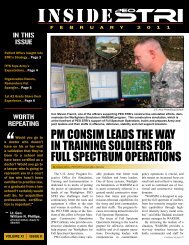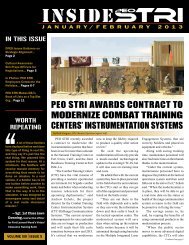W900KK-09-D-0006 - PEO STRI - U.S. Army
W900KK-09-D-0006 - PEO STRI - U.S. Army
W900KK-09-D-0006 - PEO STRI - U.S. Army
You also want an ePaper? Increase the reach of your titles
YUMPU automatically turns print PDFs into web optimized ePapers that Google loves.
<strong>W900KK</strong>-<strong>09</strong>-D-<strong>0006</strong><br />
Page 39 of 124<br />
the level of effort as proposed by the Contractor. In performing term form task orders, the Contractor may use any<br />
combination of hours of the labor categories listed in the task order.<br />
(2) In performing term form task orders, the contractor may use any combination of hours of the labor<br />
categories listed in the task order.<br />
(3) Within thirty days after completion of the work under each term form task order, the Contractor shall<br />
submit the following information directly, in writing, to the ordering officer, with copies to the COR and the<br />
Defense Contract Audit Agency office to which vouchers are submitted:<br />
(i) The total number of man-hours of direct labor, including subcontract labor, expended and a breakdown of<br />
this total showing the number of man-hours expended in each direct labor classification listed in the task order<br />
schedule, including the identification of the key employees utilized;<br />
(ii) The Contractor's estimate of the total allowable cost incurred under the task order; and<br />
(iii) In the case of a cost under run, the amount by which the estimated cost of the task order may be reduced<br />
to recover excess funds.<br />
(4) In the event that less than one hundred (100%) percent of the established level of effort of a term order (or<br />
if said level of effort has been previously revised upward, of the fee bearing portion of the additional hours by<br />
which the level of effort was last increased) is actually expended by the completion date of the contract, the<br />
Government shall have the option of:<br />
(i) Requiring the Contractor to continue performance, subject to the provisions of the "Limitation of Cost" or<br />
the "Limitation of Funds" clause, as applicable, until the effort expended equals one hundred (100%) percent of the<br />
established Level of Effort (or of the fee-bearing portion of the last upward revision); or<br />
(ii) Effecting a reduction in the fixed fee by the percentage by which the total expended man-hours is less<br />
than one hundred (100%) percent of the established Level of Effort (or the fee bearing portion of the last upward<br />
revision).<br />
(5) In the event that the expended level of effort of a term order exceeds the established level of effort by ten<br />
(10%) percent or less, but does not exceed the estimated cost of the order; the contractor shall be entitled to cost<br />
reimbursement for actual hours expended, not to exceed the ceiling cost. The contractor shall not be paid fixed fee,<br />
however, on level of effort in excess of one hundred (100%) percent without complying with subsection (e)(1)<br />
above. This understanding does not supersede or change subsection (e)(1) above, whereby the contractor and<br />
Government may agree on a change to the task order level of effort with an equitable adjustment for both cost and<br />
fee.<br />
CLAUSES INCORPORATED BY FULL TEXT<br />
5152.211-5004 LEVEL OF EFFORT (TIME-AND-MATERIALS AND LABOR-HOUR CONTRACTS) (<strong>PEO</strong><br />
<strong>STRI</strong>) (SEP 2006)<br />
(a) Task orders shall establish an anticipated level of effort (projected man-hours) for each CLIN or SLIN and a<br />
Ceiling Price for that task order. The ceiling price shall be the sum of: (1) the projected prime Contractor hours<br />
multiplied by the appropriate hourly rates prescribed in the schedule; and (2) the estimated amount of materials<br />
priced in accordance with the clause entitled, Payments Under Time-and-Materials and Labor-Hour Contracts,<br />
including estimated subcontract costs calculated in the same manner as the prime Contractor using the subcontract<br />
price schedules.<br />
(b) The Contractor may use any combination of hours of labor categories listed in any single task order, if<br />
necessary to perform that task order. Labor categories not shown may not be used without a task order

















